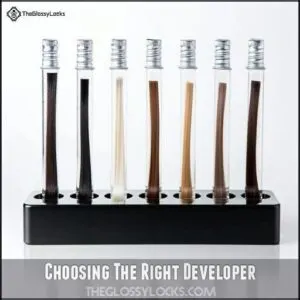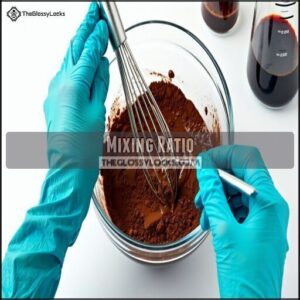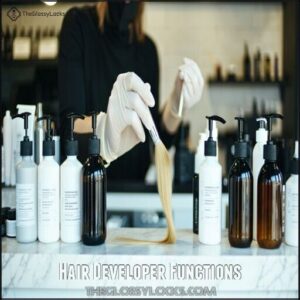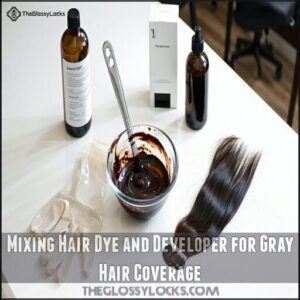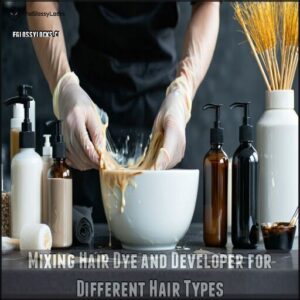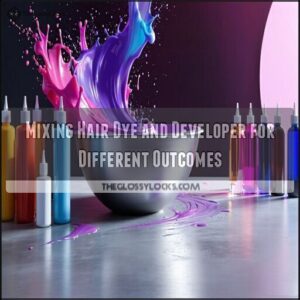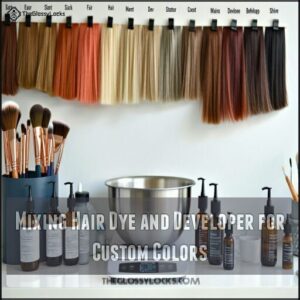This site is supported by our readers. We may earn a commission, at no cost to you, if you purchase through links.
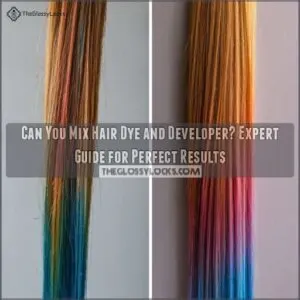 Yes, you must mix hair dye and developer together before application—they’re designed to work as a team.
Yes, you must mix hair dye and developer together before application—they’re designed to work as a team.
The developer opens your hair cuticle and activates the dye, allowing color to penetrate effectively.
For permanent color, use a 1:1 or 1:2 ratio depending on your product’s instructions.
Always mix in a non-metallic bowl using plastic or wooden tools to prevent chemical reactions.
Don’t skip this step or you’ll end up with patchy, uneven results that won’t last.
The right mixing technique can mean the difference between salon-worthy color and a hair emergency waiting to happen.
Table Of Contents
- Can You Mix Hair Dye and Developer?
- Mixing Hair Dye and Developer
- Choosing The Right Developer
- Mixing Tips
- Benefits of Hair Developer
- Mixing Ratio
- Hair Developer Functions
- Mixing Hair Dye and Developer for Gray Hair Coverage
- Mixing Hair Dye and Developer for Different Hair Types
- Mixing Hair Dye and Developer for Different Outcomes
- Mixing Hair Dye and Developer for Custom Colors
- Frequently Asked Questions (FAQs)
- Can I Mix Hair Dye and Developer Together in Advance?
- What Happens if I Use Too Much Developer?
- What Happens if I Use Too Little Developer?
- Can I Use Hair Dye Without Developer?
- What happens when you mix hair dye with developer?
- How much developer do I mix with hair dye ion?
- How much 30% developer do I mix with hair dye?
- Can I use 20 volume developer with permanent color?
- Can you mix developer and hair dye?
- Can hair dye damage split ends?
- Conclusion
Can You Mix Hair Dye and Developer?
Yes, you can mix hair dye and developer—it’s actually essential for permanent color. This chemical partnership opens hair cuticles and deposits color molecules.
Your hair’s porosity determines the perfect developer strength, while the developer to dye ratio (typically 1:1 or 1:2) guarantees the best results.
Always use proper mixing tools like plastic bowls and brushes. Understanding color theory basics helps prevent disasters and lets you safely achieve that salon-quality transformation at home.
To achieve the best results, consider the importance of dye compatibility considerations when working with different types of hair dye.
Mixing Hair Dye and Developer
When preparing to transform your hair color, mastering the hair dye and developer mixing process is essential for achieving your desired results.
To create the perfect mixture:
- Gather appropriate mixing tools: non-metal bowl, plastic applicator brush, and protective gloves
- Measure your hair dye and developer according to the recommended developer to dye ratio (typically 1:1 or 1:2)
- Combine ingredients gradually, stirring until you achieve smooth dye consistency
- Adjust mixture based on your hair porosity for ideal color depth
- Perform a strand test to confirm proper dye activation
Always use plastic or glass bowls as metal can interfere with the chemical reaction. The mixture should have a creamy, yogurt-like texture—not too runny or too thick. Check product instructions for exact mixing hair color and developer ratios specific to your chosen brand.
Choosing The Right Developer
You’ll need to select the right developer strength based on your desired color result and hair type.
The volume you choose (10, 20, 30, or 40) determines how much lift or lightening occurs when mixed with your hair dye.
Developer Volume Selection
Selecting the right developer volume is your color transformation’s backbone.
Developer strength directly affects how much your hair lifts and how vibrant your final shade appears.
For gentle color depositing without lightening, 10-volume (3% peroxide) works perfectly.
For gentle color depositing without lightening, 10-volume (3% peroxide) works perfectly. Need standard coloring with 1-2 levels of lift? 20-volume (6%) is your go-to.
Need standard coloring with 1-2 levels of lift? 20-volume (6%) is your go-to.
For more dramatic transformations with medium lift, 30-volume (9%) delivers results.
While 40-volume offers maximum hair lift with 12% concentration, it’s best left to professionals.
Your hair type and desired color depth determine the ideal hair dye developer ratio and processing time.
Understanding hair color levels is essential for achieving the desired shade and selecting the right developer.
Desired Color Outcome
After selecting your developer volume, your desired color outcome becomes the roadmap for mixing success.
The right hair dye to developer ratio directly impacts your color intensity and final look.
Your color journey depends on three key factors:
- Shade selection – Choose colors within 2-3 shades of each other for harmonious blending
- Color depth planning – Maintain the correct hair color mixing ratio (typically 1:1 for most brands)
- Tone enhancement – Consider your current shade as your starting point
Remember that developer to dye ratio affects your results dramatically. Too much developer creates lighter but less vibrant results, while too little gives darker but potentially patchy coverage.
For those vibrant results you’re dreaming of, precision matters most. Think of your mixing bowl as a chemistry lab where small adjustments make big differences. To achieve salon-quality results, understanding hair color mixing is essential for the best outcome.
Hair Type Consideration
Now that you’ve chosen the right color, let’s consider how your hair type affects your dye and developer formula.
Your unique hair structure demands a customized approach.
Fine hair works best with a gentler 1:1 hair dye to developer ratio, preventing excessive damage.
Thick hair or curly locks typically need a 1:2 mixing ratio for proper color penetration and even results.
For those with a dry scalp, opt for lower volume developers and consider pre-treating with a nourishing oil.
If you battle oily roots, focus application away from the scalp initially.
Hair porosity matters too—highly porous hair absorbs color quickly and may need less processing time.
Previously colored or damaged strands require extra care, often benefiting from a 10 or 20-volume developer.
Remember, the perfect hair color formula isn’t one-size-fits-all—what works for straight hair mightn’t suit your gorgeous curls!
Mixing Tips
The artistry of mixing hair dye requires precision and the right tools for salon-worthy results at home.
Now that you’ve chosen your developer, mastering the mixing process is your next critical step.
Follow these expert hair dye mixing tips:
- Use plastic or glass mixing tools – metal can chemically react with your dye and alter the color
- Measure precisely with a digital scale for consistent hair color mixing results
- Mix until you achieve a smooth, yogurt-like consistency without any lumps
- Conduct a strand test before full application to confirm your chosen shade
- Maintain proper ratios according to manufacturer’s hair dye mixing instructions
Apply your mixture immediately after mixing – developer starts working right away.
For best results, section your hair before mixing to guarantee efficient application. The mixing method matters just as much as the application technique.
When combining developer with color, mix thoroughly but don’t whip air into the mixture, as this can affect color deposit.
Benefits of Hair Developer
Five essential benefits make hair developer your secret weapon for perfect coloring results.
This hydrogen peroxide solution lifts hair cuticles, allowing for deeper dye penetration and superior color enhancement.
Developers come in different strengths (10-40 volume), each offering varying levels of lift while providing hair protection through conditioning agents.
Hair developers aren’t just chemicals—they’re your color transformation allies offering both lift and protection in every application.
Quality developers actually strengthen hair texture during the coloring process, preventing damage and adding shine.
They guarantee even application and long-lasting results when mixed at the correct hair dye developer ratio.
For ideal effectiveness, store your developer in a cool, dark place.
With the right developer, you’ll achieve vibrant, professional-looking color every time, and it will be your secret weapon for perfect coloring, ensuring long-lasting results.
Mixing Ratio
The perfect hair dye results begin with mastering the correct mixing ratio. Standard ratios typically follow a 1:1 developer to dye ratio, though this varies based on your desired outcome and product instructions.
You can purchase products related to hair dye developer ratios.
- Anxiety about ruining your hair with improper measurements
- Satisfaction when achieving that perfect consistency
- Confidence in handling professional-level mixing techniques
- Relief when the color blends smoothly
- Anticipation as you prepare to transform your look
- Pride when friends ask if you visited a salon
For permanent color, stick to the 1:1 hair dye developer ratio indicated on your product label. When seeking more dramatic changes, you might need a 1:2 ratio. Always use a digital scale for measuring ingredients accurately, and check your mixture’s consistency before application. Remember: adjusting ratios based on hair type guarantees even color distribution—thicker hair often needs slightly more product for complete coverage.
Hair Developer Functions
While mixing ratios determine your formula’s strength, understanding what hair developer actually does transforms you from novice to expert colorist.
Hair developer functions as a powerful oxidizing agent, performing four essential tasks:
- Opens the hair cuticle like a key releasing doors, allowing color to penetrate deeply
- Activates pigment molecules in the dye through chemical reactions
- Controls lightening power by lifting your natural color (stronger volumes = more lift)
- Regulates processing speed – 10 volume works gently, while 40 volume acts quickly
Developer strength directly impacts your results. For subtle changes, stick with 10-20 volume. For dramatic transformations, 30 volume provides more lifting power without excessive damage.
Mixing Hair Dye and Developer for Gray Hair Coverage
Effectively tackling stubborn gray hair requires precise mixing techniques for lasting coverage.
When combining hair dye developer with color for grays, attention to detail makes all the difference.
- Choose a 20-volume developer strength specifically designed for gray hair coverage
- Mix permanent dye with developer at a 1:1 Gray Coverage Ratio for superior results
- Apply mixture to resistant areas first where different gray hair types may be more concentrated
- Allow proper processing time (usually 30-45 minutes) for complete penetration
- Section hair methodically to guarantee no grays escape treatment
Start application at the roots where grays typically cluster, working through each section carefully.
The mixing ratio is vital – too much developer dilutes color intensity, while too little prevents proper penetration.
Remember, successful hair color application techniques aren’t rushed; taking your time guarantees those stubborn silver strands surrender completely.
Mixing Hair Dye and Developer for Different Hair Types
Your hair type directly influences the perfect hair dye developer ratio for ideal results.
Fine hair benefits from a gentler 1:1 mix to prevent damage, while thick hair needs a stronger 1:2 ratio for proper penetration.
Those with fine hair can find suitable hair developer products online.
High-porosity strands require less developer, but low-porosity locks need more for color to take hold.
Curly hair typically works best with lower volume developers to maintain moisture.
Those with oily scalps may need slightly stronger mixing ratios for lasting color.
Always test a small section first—your specific hair texture ultimately determines your ideal hair color developer formula.
Mixing Hair Dye and Developer for Different Outcomes
How can you achieve your dream hair color? Understanding the right hair dye developer ratio is key to successful color transformations.
- For vibrant, long-lasting results, mix permanent color in a 1:1.5 dye-to-developer ratio
- Combat resistant grays with 20 volume developer and extend processing time by 5-10 minutes
- Create gentle color deposits on damaged hair using a 1:2 mix with 10 volume developer
- Boost color penetration on low hair porosity by adding 1 tbsp of Argan oil per 100ml mixture
- Achieve dramatic lifting with 30 volume developer for 2-3 shade differences
- Use proper mixing tools (plastic bowls and brushes) to guarantee even color distribution
Color correction becomes simple when matching these formulas to your desired outcome, turning your DIY coloring session into salon-quality results.
Mixing Hair Dye and Developer for Custom Colors
Beyond standard hair coloring lies the artistic world of custom color creation. When you’re ready to craft your unique shade, proper mixing technique matters.
Creating your signature color requires understanding the science behind blending:
- Pair complementary color families – warm tones with warm, cool with cool for harmonious results
- Select appropriate developer strength (10-volume for subtle changes, 30-volume for dramatic lifts)
- Maintain proper hair dye developer ratio (typically 1:1 or 1:2 depending on desired intensity)
- Consider your hair porosity before finalizing measurements
- Document your dye formulas precisely for consistent future application
Custom blending works best when dyes remain within 2-3 shades of each other. For predictable results, stick with one brand’s color system and test small sections before full application.
Frequently Asked Questions (FAQs)
Can I Mix Hair Dye and Developer Together in Advance?
Over 80% of DIY color mistakes happen from poor prep.
Mixing hair dye and developer in advance isn’t ideal—it weakens effectiveness.
Always mix them fresh before application for the best, vibrant, and lasting results!
What Happens if I Use Too Much Developer?
If you use too much developer, the color won’t deposit properly, leaving your hair lighter than expected and uneven.
It dilutes the dye, so you risk a washed-out look instead of rich, vibrant results.
What Happens if I Use Too Little Developer?
Using too little developer can leave your color uneven or fail to activate the dye properly.
Instead of rich, vibrant results, you’ll likely get patchy coverage or barely-there color—like missing the perfect punchline.
Can I Use Hair Dye Without Developer?
Yes, you can, but only if you’re using semi-permanent dye.
It doesn’t need a developer since it coats your hair instead of penetrating.
Permanent dyes always require a developer to activate and deliver lasting color.
What happens when you mix hair dye with developer?
Imagine baking without mixing ingredients properly—chaos, right?
Combining hair dye and developer activates the dye, allowing it to penetrate your hair.
Too much developer weakens color; too little leads to uneven coverage.
Balance is key!
How much developer do I mix with hair dye ion?
For Ion hair dye, mix one part color with two parts 10, 20, 30, or 40-volume Ion developer, depending on your desired result. Follow Ion’s instructions carefully to guarantee smooth, vibrant color.
How much 30% developer do I mix with hair dye?
Think of it like baking a cake—too much or too little changes everything. For30-volume developer, mix it with hair dye typically at a1:1 or1:2 ratio, per product instructions.
Can I use 20 volume developer with permanent color?
You can absolutely use 20-volume developer with permanent color.
It works well to cover gray, darken hair, or achieve subtle lightening.
Just follow the dye’s mixing instructions carefully for consistent, vibrant, and safe results!
Can you mix developer and hair dye?
Yes, you can mix hair dye and developer.
Stick to the instructions and ratios provided with the products. Proper mixing guarantees vibrant, even color.
Use a non-metal bowl, gloves, and mix until smooth.
Always patch test!
Can hair dye damage split ends?
Split ends are like the freeloaders of your hair—they’re already weak and fragile.
Using hair dye can worsen damage by drying them further, so trim those ends first for healthier, more vibrant results.
Conclusion
Did you know over 70% of DIY hair color mishaps happen due to improper mixing?
When you mix hair dye and developer correctly, you set yourself up for vibrant, long-lasting results. Follow the product’s ratio guidelines—usually 1:1 or 1:2—and always use a non-metallic bowl to avoid chemical reactions.
By taking your time and understanding how the developer works, you’ll achieve even coverage and avoid patchy results. It’s easy when you’ve got the right technique!
- https://www.shopsalonproducts.com/blogs/news/how-to-mix-hair-color-and-developer-correctly-for-perfect-results
- https://www.stylecraze.com/articles/what-is-hair-developer/
- https://www.glamot.com/blog/26432/how-to-choose-right-developer-for-hair-color
- https://www.bangstyle.com/posts/what-volume-developer-should-i-use-4299
- https://gkhair.eu/blogs/all-blogs/hair-color-levels-and-different-volumes-of-developers

